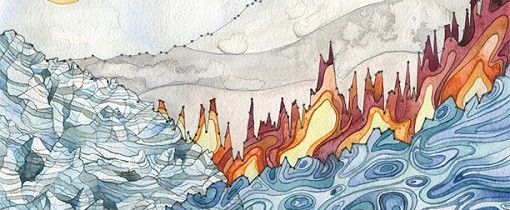International report confirms Earth is hot and getting hotter
A new State of the Climate report confirmed that 2015 surpassed 2014 as the warmest year since at least the mid-to-late 19th century. Last year’s record heat resulted from the combined influence of long-term global warming and one of the strongest El Niño events the globe has experienced since at least 1950. The report found that most indicators of climate change continued to reflect trends consistent with a warming planet. Several markers such as land and ocean temperatures, sea levels and greenhouse gases broke records set just one year prior.
These key findings and others are available from the State of the Climate in 2015 report released online today by the American Meteorological Society (AMS).
The report, led by NOAA National Centers for Environmental Information, is based on contributions from more than 450 scientists from 62 countries around the world and reflects tens of thousands of measurements from multiple independent datasets (highlights, full report(link is external)). It provides a detailed update on global climate indicators, notable weather events and other data collected by environmental monitoring stations and instruments located on land, water, ice and in space.
“This ‘annual physical’ of Earth’s climate system showed us that 2015’s climate was shaped both by long-term change and an El Niño event,” said Thomas R. Karl, L.H.D., Director, NOAA National Centers for Environmental Information. “When we think about being climate resilient, both of these time scales are important to consider. Last year’s El Niño was a clear reminder of how short-term events can amplify the relative influence and impacts stemming from longer-term global warming trends.”
The report’s climate indicators show patterns, changes, and trends of the global climate system. Examples of the indicators include various types of greenhouse gases; temperatures throughout the atmosphere, ocean, and land; cloud cover; sea level; ocean salinity; sea ice extent; and snow cover.
Report highlights include these indications of a warming planet:
- Greenhouse gases highest on record. Major greenhouse gas concentrations, including carbon dioxide (CO2), methane and nitrous oxide, rose to new record high values during 2015. The annual average atmospheric CO2 concentration at Mauna Loa, Hawaii, the location of the world’s longest direct measurements of CO2, was 400.8 parts per million (ppm), which surpassed 400 ppm for the first time. This was 3.1 ppm more than 2014, and was the largest annual increase observed in the 58-year record. The 2015 average global CO2 concentration was not far below, at 399.4 ppm, an increase of 2.2 ppm compared with 2014.
- Global surface temperature highest on record. Aided by the strong El Niño, the 2015 annual global surface temperature hit record warmth for the second consecutive year, easily surpassing the previous record set in 2014 by more than 0.1°C (0.2°F). This exceeded the average for the mid- to late 19th century — commonly considered representative of preindustrial conditions — by more than 1°C (1.8°F) for the first time. Across land surfaces, record to near-record warmth was reported across every inhabited continent.
- Sea surface temperatures highest on record. The globally averaged sea surface temperature was also the highest on record, breaking the previous mark set in 2014. The highest temperature departures from average occurred in part of the northeast Pacific, continuing anomalous warmth there since 2013, and in part of the eastern equatorial Pacific, reflective of the dominant El Niño. The North Atlantic southeast of Greenland remained colder than average and was colder than 2014.
- Global upper ocean heat content highest on record. Globally, upper ocean heat content exceeded the record set in 2014, reflecting the continuing accumulation of thermal energy in the upper layer of the oceans. Oceans absorb over 90 percent of Earth’s excess heat from global warming.
- Global sea level highest on record. Global average sea level rose to a new record high in 2015 and was about 70 mm (about 2¾ inches) higher than the 1993 average, the year that marks the beginning of the satellite altimeter record. Over the past two decades, sea level has increased at an average rate of 3.3 mm (about 0.15 inch) per year, with the highest rates of increase in the western Pacific and Indian Oceans.
- Extremes were observed in the water cycle and precipitation. A general increase in the water cycle, combined with the strong El Niño, enhanced precipitation variability around the world. An above-normal rainy season led to major floods in many parts of the world. But globally, areas in “severe” drought rose from 8 percent in 2014 to 14 percent in 2015.
The report also documents key regional climate and climate-related events:
- The Arctic continued to warm; sea ice extent remained low. The Arctic land surface temperature tied with 2007 and 2011 as the highest since records began in the early 20th century, representing a 2.8°C (5°F) increase since that time. Average sea surface temperatures across the Arctic Ocean during August in ice-free regions ranged from near normal to 8°C above average. Increasing temperatures have led to decreasing Arctic sea ice extent and thickness. In February 2015, the maximum sea ice extent reached its largest footprint of the year, and was the smallest in the 37-year satellite record, at 7 percent below the 1981–2010 average. Minimum sea ice extent in September 2015 was 29 percent less than the 1981–2010 average and the fourth lowest value on record.
- Arctic animals and fish were impacted by changing climate. As a consequence of sea ice retreat from warming oceans, vast walrus herds in the Pacific Arctic are hauling out on land rather than on sea ice, raising concern about the energy requirements of females and young animals. Increasing temperatures in the Barents Sea are linked to a shift in fish populations: warmer-water fish are moving farther north, and long-standing Arctic species, such as gelatinous snailfish and polar cod have been almost pushed out of the area.
- Widespread harmful algal bloom impacts northeast Pacific. In the late spring and summer 2015, a widespread harmful algal bloom (HAB), stretching off the west coast of North America from central California to British Columbia, Canada, resulted in significant impacts to marine life, coastal resources and the human communities that depend on these resources. Unusually warm surface water in the Pacific is considered a factor regarding the severity and early onset of the bloom.
- Antarctic temperatures were colder than average; sea ice extent was highly variable. Temperatures across Antarctica were lower than the 1981–2010 average for most of the year. Antarctic sea ice extent and area had large variability during the year, shifting from record high levels in May to record low levels in August.
- Global ice and snow cover decline. Preliminary data indicate that 2015 was the 36th consecutive year of overall alpine glacier retreat across the globe. Across the Northern Hemisphere, late-spring snow cover extent continued its trend of decline, with June the second lowest in the 49-year satellite record. Below the surface, record high temperatures at the 20-meter (65-feet) depth were measured at all permafrost observatories on the North Slope of Alaska, with temperatures increasing by up to 0.66°C (1.2°F) per decade since 2000.
- Tropical cyclones were well above average overall. There were 101 tropical cyclones across all ocean basins in 2015, well above the 1981–2010 average of 82 storms. The eastern/central Pacific had 26 named storms, the most since 1992. The western North Pacific and north and south Indian Ocean basins also saw high activity. Similar to 2013 and 2014, the North Atlantic season was quieter than most years of the last two decades with respect to the number of storms. The overall strength of the North Atlantic storms were weaker as well, just 68 percent of the 1981–2010 median seasonal value, with Major Hurricane Joaquin accounting for nearly one-half that value.
Fonte: https://www.ncdc.noaa.gov/bams



